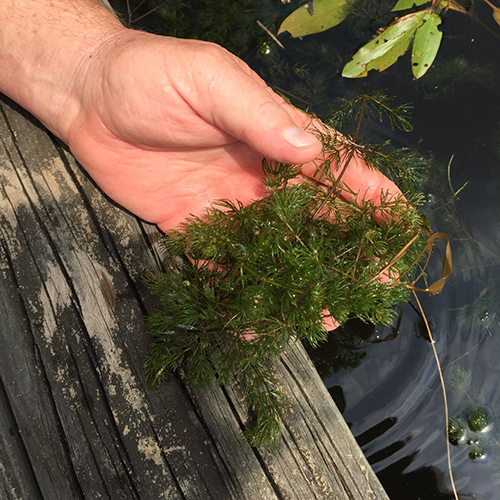Coontail Hornwort Submerged Pond Weed
Ceratophyllum demersum is a non-rooted aquatic plant that grows underwater. Stems can grow up to 11 feet long! It produces stiff and spiny green needle-like leaves. Leaves are arranged in whorls around the stem. Leaves have small teeth or bumps.
Flowers and fruit form at the base of the leaf. Unlike most other pond weeds, the flowers produced do not grow above the water surface.
Coontail and hornwort are common names for this submerged weed.
Hornwort can be confused with watermilfoil, fanwort, and chara.
Coontail vs Milfoil: Milfoil has more feather-like leaves and is more delicate. Click here to read more about watermilfoil.
Coontail vs Fanwort: anwort forms leaves that look like fans opposite of each other on stems. The stems are often red. Click here for read more about fanwort cabomba.
Where does coontail grow?
Plant growth occurs slow moving or calm water of lakes and ponds. Hornwort coontail is a free floating plant. It can grow in water deeper than 6 feet. Coontail can continue to grow throughout winter months while other aquatic vegetation goes dormant.
Reproduction occurs by seed distribution and fragmentation.
Is coontail invasive?
Ceratophyllum demersum is a native aquatic plant throughout the United States. Benefits of coontail plant include fish habitat, oxygen production and nutrient uptake.
Coontail can take over a pond if left unmanaged because there are no root systems. Rapid growth occurs when there are excess nutrients (nitrate and phosphate) in water to feed the plant. Fast growth makes it easy to outcompete other beneficial aquatic plants.
Unlike most pond weeds, hornwort releases a chemical that inhibits growth of other weeds around it. This chemical has been known to stop the growth of harmful phytoplankton.
It is not recommended to plant coontail in waterways or ponds connected to waterways.
Can I manually remove hornwort?
Ceratophyllum can be removed with rakes. Weeds will reproduce through fragmentation. It is important to remove all vegetation. Once removed you don’t have to worry about regrowth because there is no root system to re-establish.
Do grass carp eat coontail?
Grass carp will eat coontail weed. The fish tend to go after preferred weeds like naiad, chara, hydrilla, and elodea first before moving on to other varieties.

How to get rid of coontail in a pond:
Aquathol K provide excellent control of coontail. This treatment yields quick results and has no water use restrictions.
Sonar provides a long term management solution for floating hornwort. Sonar reacts slowly, taking 30-60 days for results. The entire pond must be treated for success. This treatment option is only for ponds with little or no flow coming into the pond. Sonar AS, and Sonar RTU are available options
Other weed control options:
Harvester provides fast control. To improve results, mix with Cutrine (1 qt Harvester, 1 gal Cutrine). This is a contact herbicide. It must come in contact with weeds in order to kill the vegetation.
Navigate granular herbicide is a good treatment option. Early season control is ideal because hornwort grows more towards the bottom. When water temperature increases growth floats more to the surface.
Coontail Control
Next Steps After Herbicide Treatment
Once coontail plant has been sprayed, take these proactive steps to keep the pond clean and weed free. Apply pond dye to reduce sunlight from reaching the bottom of the pond where new growth begins. Use pond dye monthly for best results. Use Muck Remover pellets to break down decaying coontail and other muck in the pond.
Need help identifying your POND WEED or How Much Treatment To Use?
